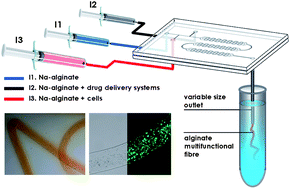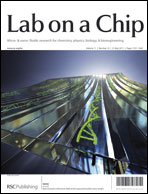This paper describes a method for the production of alginate microfibres using glass-based microfluidic chips fabricated by a photolithography-wet etching procedure. The main focus of the work is the fabrication of a cell containing multifunctional microfibres which have great potential for applications in drug release formulations and tissue engineering scaffolds (to guide the regeneration of tissues in predefined sizes and shapes) providing cell structural support and immunoisolation. The key parameters, which critically influence the formation of microfibres and their geometries, were identified by a classical intuitive approach COST (Changing One Separate factor a Time). In particular, their effects on the microfibre diameter were investigated, which are directly associated with their functionalities relating to the implantation site, the nutrient availability and diffusion/transport of oxygen, essential nutrients, growth factors, metabolic waste and secretory products. The interplay between the alginate solution concentration, pumping rate and gelling bath concentration in controlling the diameter of the produced microfibres was investigated with a statistical approach by means of a “design of the experiments” (DoEs) optimization and screening. Finally, the processing impacts on cell viability, the cellular effect of wall thickness consistency and the spatial distribution of cells within the alginate microfibre were examined. We provide an approach for the production of alginate microfibres with controlled shape and content, which could be further developed for scaling up and working towards FDA approval.

You have access to this article
 Please wait while we load your content...
Something went wrong. Try again?
Please wait while we load your content...
Something went wrong. Try again?


 Please wait while we load your content...
Please wait while we load your content...